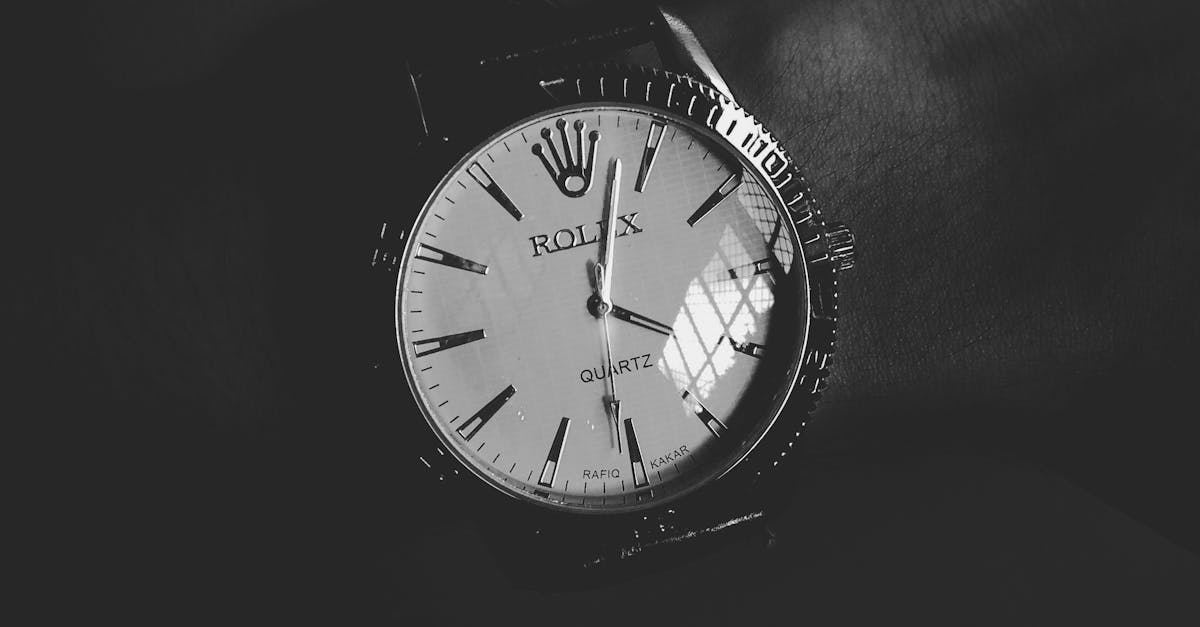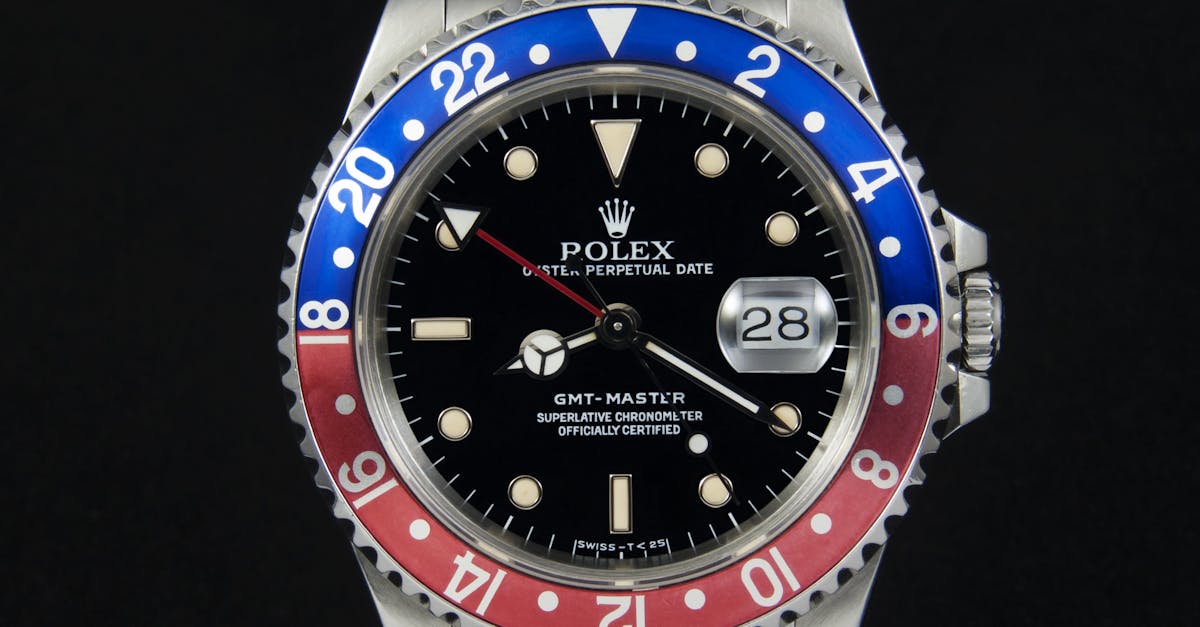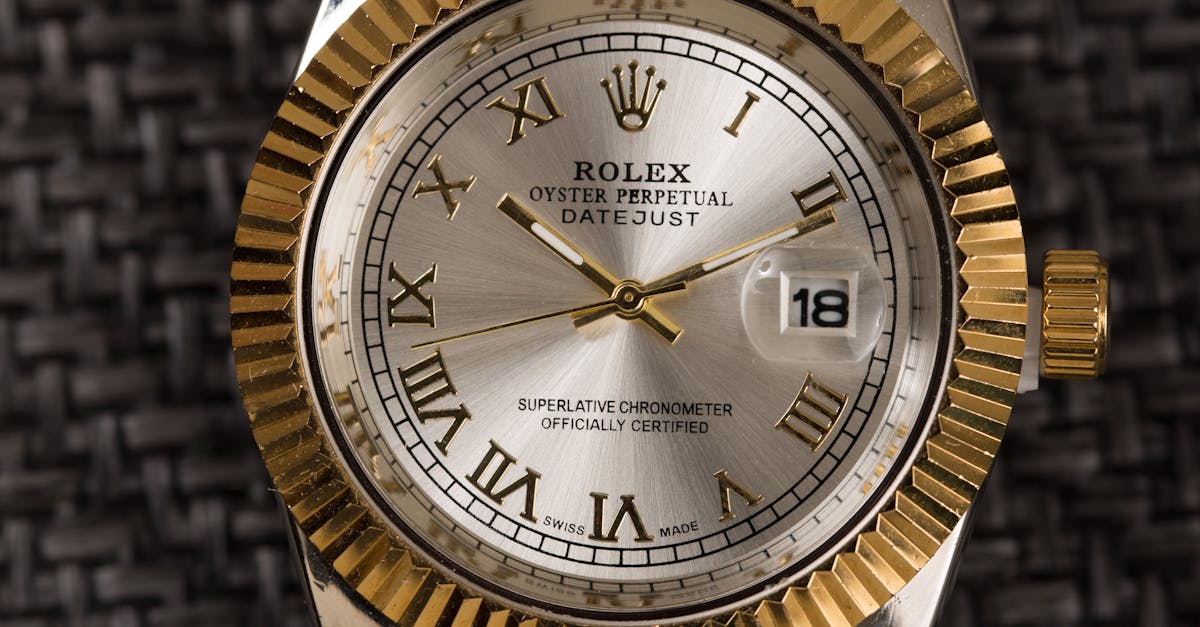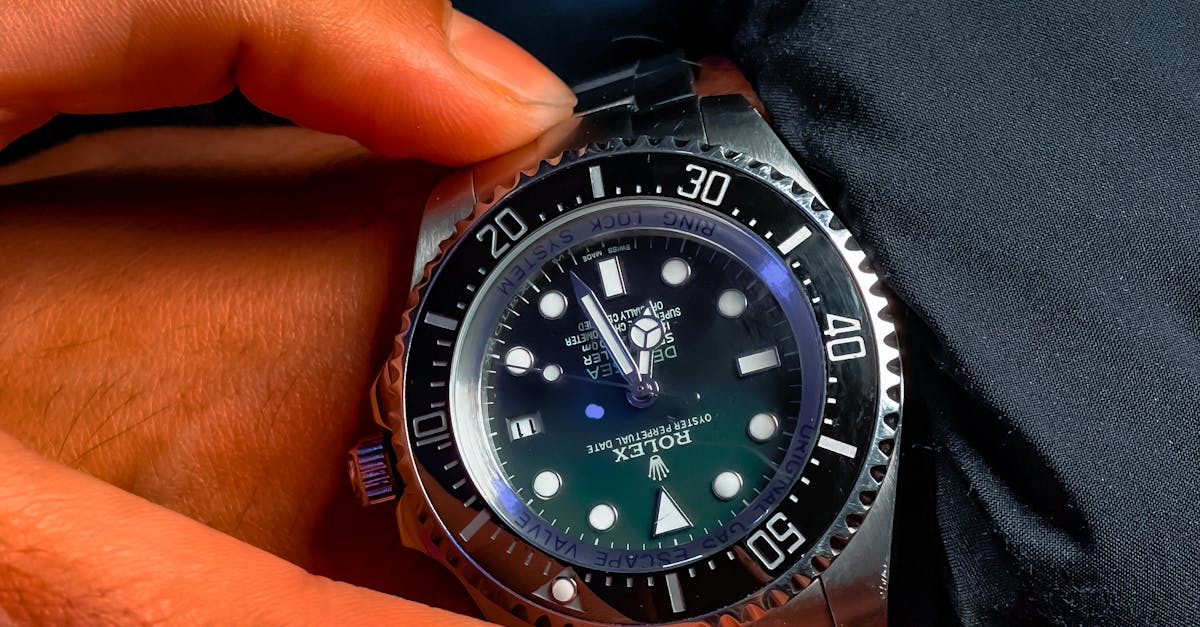Masterpieces of Time: A Legacy of Innovation and Elegance

A Journey Through Time with Rolex: From Innovation to Elegance
The name Rolex is synonymous with excellence, precision, and timeless style. For over a century, the Swiss watchmaker has been pushing the boundaries of horology, creating iconic timepieces that have become symbols of both functionality and luxury. Join us on a chronological journey through the history of Rolex watches, witnessing the evolution of design, innovation, and craftsmanship that has made the brand a legend.
From the groundbreaking waterproof Oyster to the sophisticated Datejust and Day-Date, from the rugged Submariner to the versatile GMT-Master II, each Rolex watch tells a story of human endeavor, exploration, and the relentless pursuit of perfection. Through the decades, Rolex has not only defined the aesthetics of timekeeping but has also played a pivotal role in supporting pioneering expeditions and shaping the course of history.
1. The Birth of an Icon: The Rolex Oyster
The Birth of an Icon: The Rolex Oyster
In the early 20th century, the world of watchmaking was transformed by a groundbreaking innovation: the Rolex Oyster. This revolutionary timepiece introduced a level of waterproofness that had never been achieved before, paving the way for a new era of precision and reliability. The Oyster’s creation was a testament to Rolex’s unwavering commitment to pushing the boundaries of horological excellence.
The genesis of the Oyster can be traced back to 1926, when Rolex founder Hans Wilsdorf set out to create a watch that could withstand the rigors of everyday life. Inspired by the tightly sealed compartments found in submarines, Wilsdorf developed a unique system of screw-down winding crown and case back, ensuring that no water could penetrate the watch’s interior. This innovation, combined with a synthetic crystal and a rubber gasket, created a virtually impenetrable barrier against the elements.
The Oyster’s waterproof capabilities were quickly put to the test in real-world conditions. In 1927, British swimmer Mercedes Gleitze wore an Oyster during her attempt to cross the English Channel. Despite facing treacherous conditions, Gleitze completed the swim successfully, and her Rolex emerged from the water unscathed, keeping perfect time. This daring feat garnered immense publicity for Rolex and cemented the Oyster’s reputation as the ultimate waterproof watch.
Genesis of Waterproofing: The Screw-Down Crown
Genesis of Waterproofing: The Screw-Down Crown
At the heart of the Rolex Oyster’s legendary waterproofness lies a remarkable feat of engineering: the screw-down crown. This ingenious mechanism, patented by Rolex in 1926, played a pivotal role in revolutionizing the world of watchmaking and establishing Rolex as a pioneer in water-resistant timepieces.
The screw-down crown’s design is a testament to Rolex’s meticulous attention to detail and unwavering commitment to quality. Unlike conventional crowns that simply push in and out, the screw-down crown features a series of fine threads that engage with the watch’s case. When the crown is screwed down tightly, it creates a hermetic seal, effectively preventing water from entering the watch’s interior. This simple yet effective mechanism ensures that the Oyster remains waterproof even when submerged in deep water.
The screw-down crown’s impact on the watchmaking industry was profound. Prior to its invention, watches were highly susceptible to water damage, making them unsuitable for activities such as swimming or diving. The Oyster’s waterproof capabilities, made possible by the screw-down crown, opened up new possibilities for watch enthusiasts and professionals alike. It paved the way for the development of specialized dive watches and tool watches that could withstand even the most extreme conditions.
Oyster’s Impact on Exploration and Adventure
Oyster’s Impact on Exploration and Adventure
The Rolex Oyster’s waterproof and robust construction made it the ideal companion for pioneers and adventurers embarking on daring expeditions. Its reliability and accuracy proved invaluable in the most challenging environments, from the depths of the ocean to the summit of the world’s highest mountain.
In 1931, Rolex made history when its Oyster accompanied Sir Malcolm Campbell as he broke the world land speed record, reaching an astonishing 245.73 mph (395.48 km/h). The Oyster emerged unscathed from this high-speed adventure, further solidifying its reputation as a watch that could withstand extreme conditions.
Rolex’s association with underwater exploration began in 1935, when the Oyster accompanied British diver Charles William Beebe during his record-breaking dive to a depth of 3028 feet (923 meters). The watch performed flawlessly, keeping accurate time throughout the dive and demonstrating its exceptional resistance to water pressure. Rolex’s dive watches became the preferred choice for subsequent generations of deep-sea explorers, including Jacques Cousteau and the National Geographic Society.
2. Evolution of Elegance: The Datejust and Day-Date
Evolution of Elegance: The Datejust and Day-Date
In the realm of fine watchmaking, the Rolex Datejust and Day-Date stand as timeless icons of precision and sophistication. These models embody Rolex’s unwavering commitment to excellence, combining exceptional functionality with an unparalleled aesthetic appeal.
The Datejust, introduced in 1945, was a groundbreaking timepiece that set new standards for accuracy and reliability. Its signature feature is the date window at the 3 o’clock position, which displays the current date with crystal-clear clarity. Over the years, the Datejust has evolved to include a wide range of dial options, materials, and bracelet styles, making it a versatile choice for any occasion.
The Day-Date, introduced in 1956, took the Datejust’s elegant design to new heights. This exclusive model displays both the day of the week and the date, earning it the nickname “the President’s watch” due to its popularity among world leaders and influential figures. The Day-Date is crafted from precious metals such as gold and platinum and is often adorned with diamonds, making it a symbol of prestige and success.
The Datejust: A Model of Versatility
The Datejust: A Model of Versatility
The Rolex Datejust is renowned for its exceptional versatility, adapting seamlessly to a wide range of tastes and occasions. This iconic timepiece offers a myriad of dial options, materials, and bracelet choices, empowering wearers to express their individuality and complement any style.
The Datejust’s dials come in a kaleidoscope of colors and finishes, from classic white and black to vibrant hues and shimmering mother-of-pearl. Whether you prefer the timeless elegance of a Roman numeral dial or the modern appeal of Arabic numerals, the Datejust has a dial that will captivate your heart.
In terms of materials, the Datejust is crafted from a variety of metals, including stainless steel, yellow gold, white gold, and rose gold. Each metal exudes a distinct character, allowing you to choose the perfect match for your personality and style. Whether you desire the robust durability of stainless steel or the luxurious gleam of gold, the Datejust has a material that will elevate your wrist.
The Day-Date: Epitome of Prestige
The Day-Date: Epitome of Prestige
The Rolex Day-Date exudes an aura of prestige and exclusivity unmatched by any other timepiece. Reserved for presidents, dignitaries, and influential figures, the Day-Date is a symbol of power, success, and impeccable taste. Rolex’s master artisans craft each Day-Date with meticulous attention to detail, using only the finest materials and most advanced watchmaking techniques.
The Day-Date’s most distinctive feature is its day-of-the-week display, spelled out in a full arch at the 12 o’clock position. This ingenious complication, combined with the date window at 3 o’clock, provides wearers with unmatched convenience and style. The Day-Date is available in a range of precious metals, including yellow gold, white gold, rose gold, and platinum, each exuding a unique sense of luxury and sophistication.
Beyond its exceptional functionality and exquisite materials, the Day-Date is also a testament to Rolex’s unwavering commitment to innovation. The watch’s robust construction and precise movement ensure unparalleled reliability and accuracy, making it the perfect timepiece for those who demand the very best.
3. Sport and Innovation: The Submariner and GMT-Master II
Sport and Innovation: The Submariner and GMT-Master II
In the realm of professional tool watches, the Rolex Submariner and GMT-Master II stand as icons of functionality and reliability. These timepieces were designed to meet the demanding needs of divers, pilots, and explorers, and they continue to be the preferred choice for professionals and adventure enthusiasts alike.
The Submariner, introduced in 1953, was the first watch to be water-resistant to a depth of 100 meters (330 feet). Its robust construction, unidirectional rotating bezel, and luminous dial make it an indispensable tool for underwater exploration. The Submariner has been worn by countless divers, including Jacques Cousteau and James Cameron, and it has played a vital role in numerous underwater expeditions and scientific missions.
The GMT-Master II, introduced in 1954, was developed in collaboration with Pan American World Airways to meet the needs of pilots who needed to track multiple time zones. Its ingenious 24-hour bezel and independently adjustable hour hand allow pilots to easily keep track of the time in different parts of the world. The GMT-Master II has become a favorite among travelers, pilots, and anyone who needs to manage multiple time zones.
Submariner: Master of the Deep
Submariner: Master of the Deep
The Rolex Submariner is the quintessential diver’s watch, renowned for its rugged capabilities and unwavering reliability in the face of extreme underwater pressures. Since its introduction in 1953, the Submariner has been the trusted companion of countless divers, explorers, and adventurers, accompanying them on countless underwater expeditions and scientific missions.
The Submariner’s exceptional water resistance, tested to a depth of 1,000 feet (300 meters), is a testament to Rolex’s commitment to innovation and precision engineering. Its robust Oyster case, screw-down crown, and unidirectional rotating bezel ensure that the watch remains watertight even in the most challenging conditions. The Submariner’s luminous dial and hands provide excellent visibility in low-light environments, making it easy for divers to read the time underwater.
Beyond its technical prowess, the Submariner exudes a timeless sense of style and sophistication. Its sleek design and versatile appearance make it suitable for both professional and everyday wear. Whether you’re exploring the depths of the ocean or navigating the urban jungle, the Submariner is the perfect timepiece for those who demand both functionality and style.
GMT-Master II: Time Traveler’s Companion
GMT-Master II: Time Traveler’s Companion
The Rolex GMT-Master II is the ultimate timepiece for globetrotters and aviators, seamlessly blending functionality and sophistication. Its ingenious design allows wearers to simultaneously track multiple time zones, making it an indispensable tool for those who traverse the world or navigate through different time zones.
The GMT-Master II’s most distinctive feature is its 24-hour bezel, which can be independently rotated to align with a second time zone. This allows travelers to easily keep track of the time in their home country while also being aware of the local time at their destination. The watch’s independently adjustable hour hand further enhances its functionality, enabling wearers to change the time zone without affecting the minute and second hands.
Beyond its technical prowess, the GMT-Master II exudes a sense of timeless style and elegance. Its sporty yet sophisticated design makes it suitable for both casual and formal occasions. Whether you’re navigating international time zones or simply appreciate the finer things in life, the GMT-Master II is the perfect timepiece for the modern global citizen.
What is the difference between the Rolex Datejust and Day-Date?
The Rolex Datejust and Day-Date are both iconic timepieces, but they offer different levels of functionality. The Datejust displays the date, while the Day-Date displays both the day of the week and the date. Additionally, the Day-Date is typically crafted from more precious metals, such as gold and platinum, and is considered to be more prestigious.
What is the GMT-Master II used for?
The Rolex GMT-Master II is designed for travelers and professionals who need to track multiple time zones simultaneously. Its 24-hour bezel and independently adjustable hour hand allow wearers to easily keep track of the time in their home country and their destination.
What is the water resistance rating of the Rolex Submariner?
The Rolex Submariner is water-resistant to a depth of 1,000 feet (300 meters), making it suitable for professional diving and other underwater activities.




